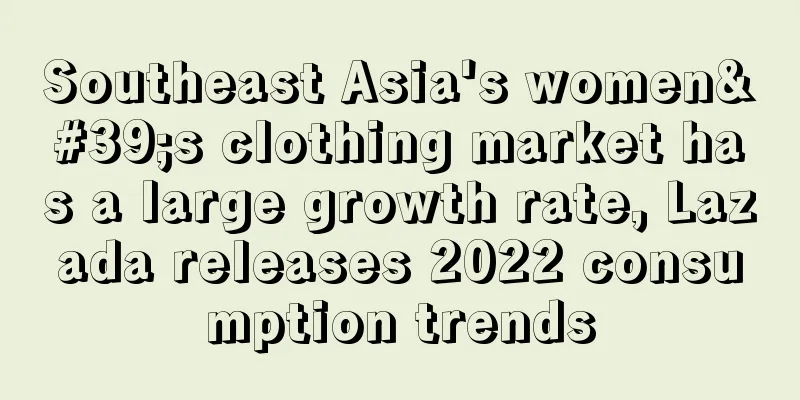Southeast Asia's women's clothing market has a large growth rate, Lazada releases 2022 consumption trends

|
Recently, Lazada released a market guide for women's clothing in the Philippines, Malaysia, and Singapore. In recent years, Southeast Asia has been one of the fastest growing regions for e-commerce in the world. As the three most popular markets in Southeast Asia, the Philippines, Malaysia, and Singapore have also received more attention.
According to the report released by Lazada, the main factors affecting the women's clothing market in these three regions include geographical location, local culture, foreign culture, etc.
The Philippines is the second largest women's clothing market in Southeast Asia and the second most populous country in Southeast Asia. From a geographical point of view, the Philippine Islands are surrounded by the sea and close to the equator. It is generally hot and humid all year round. From May to November every year is the rainy season, and there are many typhoons. Women like to wear cool suspender tops, shorts and skirts, and like bright colors and floral patterns.
Due to the profound influence of European and American culture, most Filipinos have learned English since childhood. They like European and American culture and prefer European and American style in dressing. In addition, Filipino women are also greatly influenced by Korean style. The clothing in Korean movies, TV shows and variety shows has a certain consumption guidance effect in the region.
Malaysia is the third largest economy in Southeast Asia, with strong consumption power for women's clothing. Influenced by religious customs, local consumers have a great demand for long-sleeved robes, long skirts and long pants. At the same time, the Chinese account for about one-fifth of the total population of Malaysia, and their clothing preferences are roughly the same as those of domestic consumers.
Geographically, Malaysia is close to the equator and the ocean, with hot weather and heavy humidity all year round. Therefore, clothing with sun protection, breathable and quick-drying materials will be more popular with consumers. In addition, Malaysian consumers also like loose-fitting clothing, so the sizes are larger than those in other markets. Female buyers prefer decent, elegant, comfortable and light styles. In terms of clothing style, young people prefer Japanese and Korean casual style, sports style, and elegant commuting style.
Singapore is a developed country with the highest GDP per capita in Asia. It has the most mature e-commerce market in Southeast Asia. Influenced by its geographical location, consumers prefer to choose sweat-absorbent, breathable and comfortable cotton, linen, cotton blends and silk fabrics, and relaxed, casual, modern and classic styles.
In addition, female consumers will choose different clothing styles in different scenarios. For example, they may choose elegant professional attire on weekdays, casual wear such as shirts/T-shirts, dresses, jeans, etc. on holidays, and more expensive skirts or small dresses for parties.
As the global epidemic situation gradually stabilizes, many Southeast Asian regions have begun to relax policies to stimulate the tourism industry. The number of foreign tourists or local tourists will gradually increase. For example, travelers in Singapore are already planning their year-end holidays, and many people choose to start their journey in September and October. Therefore, they have begun to prepare their vacation outfits, and the potential market is obvious.
According to the Southeast Asia Cross-border E-commerce Development Research Report released in early 2022, clothing is the second most popular category in Southeast Asia online shopping, accounting for 22%. According to iprice's Q3 2021 reading traffic data statistics, the three e-commerce platforms with the most monthly visitors in Southeast Asia are Shopee, Tokopedia, and Lazada.
In terms of e-commerce market size, data from the Southeast Asia Cross-border E-commerce Development Research Report shows that in 2021, the scale of e-commerce in the Philippines was US$12 billion, a year-on-year increase of 132%; the scale of the Malaysian e-commerce market was US$14 billion, a year-on-year increase of 68%; and the scale of the Singaporean e-commerce market was US$7.1 billion, a year-on-year increase of 45%. In these three regions, Shopee and Lazada are in the leading position in both APP downloads and website traffic.
The challenge is that Southeast Asian countries have low consumption levels, low average order value, and small profit margins for merchants. According to sales data from Shopee's Indonesian and Thai websites, the most popular women's clothing products cost about 42.8 yuan. In addition, nearly half of consumers indicated that if there were no promotions, they would be willing to choose cheaper alternatives. Southeast Asia Lazada Platform Women |
<<: 315 million units sold in one year! Another hit product in the US market is released
>>: Amazon paid more than 600 million pounds in taxes a year and received a "small" tax relief
Recommend
What is DCA International Risk Management Platform? DCA International Risk Management Platform Review, Features
DCA International Risk Management and Control Pla...
Are Amazon's "reviews" going to disappear?
According to foreign media reports, Amazon is con...
A yearly revenue of 1.4 billion still can't stop the decline in performance! What happened to this home furnishing giant?
In recent years, the global smart home market has...
What is Paravel? Paravel Review, Features
Paravel is a sustainable travel brand dedicated t...
What is Heist Studios? Heist Studios Review, Features
Heist Studios is a startup from London, UK, that s...
On Christmas Eve, a hot-selling product "crashed"!
As Christmas approaches, is everyone preparing fo...
What is Lelong.my? Lelong.my Review, Features
Lelong.my is the oldest e-commerce platform in Ma...
Foreigners don't buy it? The overseas version of Xiaohongshu is not popular in the United States
According to the latest report from foreign media...
Officially bankrupt and liquidated! Another e-commerce platform collapsed
Another home furnishing e-commerce platform close...
SHEIN recalls more than 2,000 products, this time it's a disaster
Complying with flammability standards is a very i...
Euro and US dollar exchange rates plummeted, sellers: It's heartbreaking
Recently, the exchange rates of the euro, the US ...
Target launches Latino Heritage Month collection
To celebrate the upcoming Latino Heritage Month, ...
A group of sellers were banned for following the lead
There are risks in following others to sell, so b...
What is Forever21? Forever21 Review, Features
Forever21 is a popular fashion brand that is popu...
What is Bershka? Bershka Review, Features
Bershka is a brand under Inditex and also a sister...









